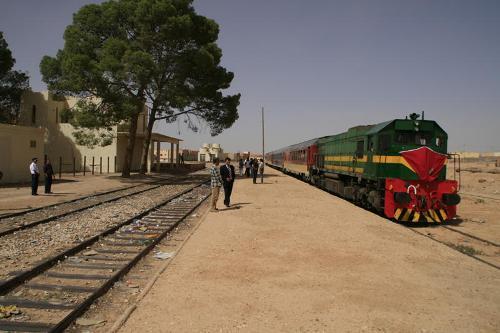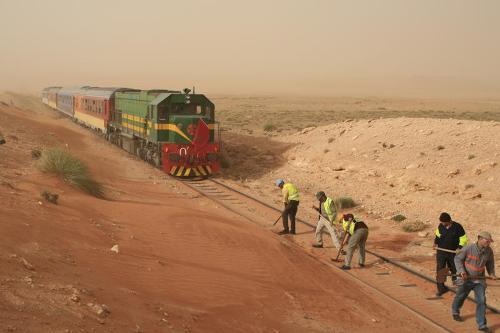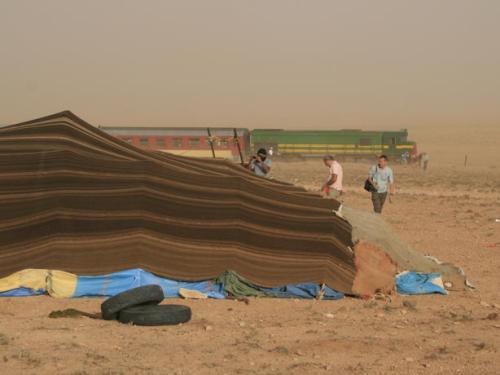Tour Review
(by Andy Pullar)
6th & 7th October 2010
Supratours / P.Wormald
The Desert Oriental Express
| Loco Used | ONCF DK559 |
| Stock Used | 1 SK ( converted to generator van), 1 sleeper, 2 coaches (the rear acting as staff accommodation) |
Route :
V15410 : Oujda to Beni Oukil
V15463 : Beni Oukil to Bouarfa
V15465 : Bouarfa to Beni Oukil
V15412 : Beni Oukil to Oujda
| Date(s) | Loco(s) | Route |
| 06/10 | DK559 | Oujda (1) – Beni Oukil – Guenfouda – Oued el Heimer – Tiouli – Fouchal – Tendrara - Bouarfa – KP305 |
| 06/10-07/10 | DK559 (2) | KP305 – Bouarfa - Tendrara – Fouchal – Tiouli – Oued el Heimer – Guenfouda – Beni Oukil - Oujda |
Notes :
(1)
Reversed into the headshunt before proceeding nonstop through Oujda.
(2)
long hood leading.
Source : Andy Pullar
![]()
Tour Review
(by Andy Pullar)
As more and more rail networks of western Europe succumbed to the infection of modern trainsets, rail enthusiasts from the UK started to search the globe for their thrills. The North African countries attracted many of these intrepid travellers drawn to the challenge of differing cultures, opportunities for track bashing and loud diesels.
It helped that a historic legacy meant that French (and in places Spanish) was a common language so not such a barrier to communication as might have been otherwise expected. I finally made the effort to join the ranks of these enthusiasts by setting foot on African soil for the first time to take part in a proposed venture to the Oriental region of Morocco.
These days it is relatively easy to reach Morocco by no frills airlines from the UK or ferries from mainland Spain. Originally, it was possible to visit using Interrail passes but this has been replaced by a Carte du Tourisme obtainable, with difficulty, at stations on the nationalised Moroccan rail network; the ONCF. The current passenger network from Marrakesh in the south to Oujda in the north east is easily covered in a week. The lines west of Fes are electrified at 3000v dc overhead whilst to the east of Fes diesel locos hold sway. It was because of these diesel locos that the idea of this charter was conceived.
There exists a single track freight line at the eastern end of the ONCF network that crosses the eastern extremities of the Moyen Atlas Mountains climbing steadily to a high, arid plateau, where the bleak, reddish-brown landscape is dotted with the tents of the semi-nomadic sheep farmers, to the mining town of Bouarfa. The summit of the entire ONCF network is reached near Tendrara in the process.
Until the early 1990s the line from Oujda to Bouarfa had one passenger train each week; southbound on Saturdays and northbound on Sundays. Freight traffic, consisting only of barium from mines high on the mountainside above Bouarfa, is the one reason for the line's inception in 1927 (the line reaching Bouarfa in 1931) and its survival today. Production from the mines is irregular, sometimes resulting in one train per week, occasionally generating up to two trains per day. The barium travels by train as far as Beni Oukil, where it is transferred to lorries for the 200 km journey by road to the port of Nador (despite Nador now being connected by rail).
It had not gone unnoticed that a tourist charter train ran along this line four or five times a year as part of a circular tour of Morocco by train and luxury coach at a cost of 1625 Euros (the latest advertised ching). The train only carried passengers southbound to Bouarfa so enquiries were made about the possibility of rail enthusiasts travelling on the ECS at considerably less cost than the full tour. An encouraging response was received by the enquirer who acted as agent and organiser for those of us that indicated our interest. To cut a long story short the Desert Oriental Express of the 6th October was born.
The participants from the UK eventually numbered around ten desperate souls that had made their independent way to Oujda to be joined by a number of journalists and an unexpected VIP tagging along for the trip. I was the last to arrive in this frontier town, on the day train from Tanger, after an eventful baptism to Morocco. I lost my wallet and rail pass on the first full day in the country. Though I tracked the wallet and rail pass down to the station master in Marrakesh it was not a surprise to find the contents had been disturbed and a quantity of money liberated. Bizarrely the considerate thief had left £40 and a hundred Croatian kuna note in the wallet. Welcome to Morocco! Of such things adventures are spawned.
Word got to me the 07.30 departure had been changed to 08.00 with an 05.30 return rather than 03.00. Chance for a lie in then and delight at not having booked a second night in an Oujda hotel. No. It was a quick breakfast and a leap to the carriage sidings to watch at first hand the preparation of the stock for the charter with a couple of other prospective travellers. Eschewing the sanctity of the passenger coaches in the consist, and the company of the VIP and paparazzi, seats in the generator car were occupied for a behind the loco ride into the desert. The usual motive power for the Desert Oriental Express is a 3,300 hp General Motors diesel (ONCF DH class), maintained at the depot in Oujda, fitted with special air filters to protect them against the extreme conditions encountered en route.
However, for this trip a smaller 2,200hp GM (ONCF DK class) had been requested for the rarity value. DK 559 duly produced. All lines, including the closed border crossing into Algeria access Oujda station from the north so it was no surprise when at eight o’clock precisely the charter train headed south. First stop the headshunt followed by a non stop run through the station, past the signal box and onto the single track mainline towards Fès.
The loco depot was passed by the left hand side before the charter turned westward, passing the truncated remains of the avoiding line and the line to Algeria veering to the right. After just over 16kms the Beni Oukil block post was reached where the tour was to leave the main line and head south into the wild oriental Moroccan landscape. First, however, was a booked wait, during which time an eastbound overnight passenger train arrived and made a stop by special order to connect with the charter. A seminar photo was taken before the order to board the train was given. After 1.5km the branch turned south away from the main line and the excitement onboard mounted. After the first photo stop the train proceeded to Guenfouda where the track bashers got more excited. The closed 41 km branch to the anthracite mining area of Jerada was not, in fact, closed. It had reopened for the import of coal from Poland through the Meditteranean port of Beni Nsar; itself only rail connected in the last year through the construction of a 118km branch line from Taourirt on the Fez to Oujda main line.
Excitement was soon over as the train only stopped to pick up a p.way gang and their shovels. Next stop involved the only runpast of the trip at the southern portal of the Tunnel de Tiouli; line’s only tunnel. The first runpast was spoilt by one of the paparazzi deciding to wind everyone up by perching himself on top of the tunnel. No matter where you go you cannot get away from undesirables getting in your photos. Queue runpast take 2 before the train pottered on at a leisurely 50kph maximum line speed. At Ain Beni Mather (kp 105.5) a stop was made in the station for photographs and the amusement of the local population. After departure, lunch, included in the cost of the trip, was served on board from a tagine using a heath robinson gas ring set up in a seatless compartment in the generator van. Folding tables were erected in each occupied compartment upon which the plates of food were laid. Liquid refreshment was also provided at additional cost. It was not a dry train even if the terrain outside was.

DK559 during the lunch stop at Ain Beni Mather (photo: Andy Pullar)
The train, whilst heading south was also gaining in altitude. From 550m above sea level at Oujda to 925m at Ain Beni Mathar. The summit was to be reached around Tendrara station at 1374m above sea level. But before then, after seeing evidence of recent rainfall in the form of standing water, the train had to negotiate a regular phenomenon of the region; drifting sand. The p.way gang on board were soon put to use clearing the track in the face of the sand storm raging around them. Meanwhile those on the train were coated in dust as they ate. The sand found its way into the train even with all the windows shut. Lunch, and the beer to wash it down with, became rather crunchy as a result.
The stops for the track to be cleared became photo opportunities, partake of free exfoliation cosmetology and a chance to watch scarab beetles scurry about their business in the sand. No scorpions were encountered on the trip but perhaps that was for the good. At somewhere with passing loops in the middle of nowhere, known to the train crew as El Terarid, a train crew change took place. Another photo opportunity. Concern mounted that Bouarfa would not be reached in daylight.

After el Terarid it was sand, not leaves on the line... (photo: Andy Pullar)
An impromptu cultural visit was arranged en-route. The train stopped close to a nomad tent pitched near the railway line. Concern grew about reaching Bouarfa in daylight as the owners of the tent invited train participants to view the inside of their dwelling.

Impromptu
cultural visit to a nomad tent (photo: Andy Pullar)
A stop at Tendrara drew the attention of the police and military because of the close proximity of the Algerian border. So close that all the mobile phones onboard received a welcome to Algeria text message as concern mounted about reaching Bouarfa in daylight. After Tendrara the line makes a steep descent off the plateau to reach the site of Bouarfa station mines above the town.
Realisation finally dawned on the participants as the sun set over the Atlas Mountains that Bouarfa was unlikely to be reached in daylight. The p.way gang were out again shifting sand off the tracks (I bet they wished it was leaves) as the short dusk gave way to night. Concern grew that we would not reach Bouarfa before midnight (or at all).
After much shovelling of sand the train inching its way south through the darkness. Bouarfa was finally reached (1269m above sea level) at about 20:30. The VIP was serenaded by a group of nomadic children rounded up for the occasion and the loco uncoupled only to be coupled up again. The end of the line had not been reached. Everybody piled back onto the train in the expectation of running into the mine sidings some 3 kilometres or so further on but 0.4km later at Kp305 the train stopped as we were reversed back to Bouarfa station, defeated by the curvature of the track.
Once again everyone bailed off the train but this time it was for arranged transport into the town and its only hotel for dinner. Chicken was on the menu which soon disappeared down ravenous throats, but not before everyone had attempted to wash the Sahara off their faces and hands. I shook hands with the VIP not realising I had managed to coat them in oil from somewhere in the mini bus; having had to kneel on the floor or else walk to the hotel. Needless to say I made sure I was one of the first on the bus back up to the station.
Shortly before 22:30 everyone that was returning to Oujda by the train piled onboard and crashed into the sleeping car. Needless to say the VIP, paparazzi and a couple of others forsook this part of the trip for a hotel bed (not all in the same one of course) and a bus or car the following day. Just as everyone was wondering when the train would leave it did. I couldn’t resist some window hanging to gaze at the wonders of the universe twinkling in the heavens (no light pollution in the desert) until the train had passed the point where the former line to Bechar in Algeria trailed in. It was interesting to note the track was still there are far as could be seen (not far as it was dark) except the points had been removed. Then it was a sleep deprivation snooze until shortly before Oujda and journeys end.
Some had woken from their slumbers early and noted a southbound DH hauled freight train at Guenfouda and that the charter train had used the loop track around the island platform at Beni Oukil before rejoining the main line at the east end. Upon arrival at Oujda just before 06:50 many headed for hotels for breakfast and a clean up. I sorted my reservations for my return to Fes and then leapt aboard the 07:10 westbound departure in search of a former SNCF 72000 for haulage. A two hour fester at Taourirt and I was in luck; CC72020 arrived disguised as ONCF DF119 and ran round its train for my 117 km hop to Taza. At Taza I leapt on the eastbound back to Taourirt to connect with the new passenger service to Beni Nsar Port. I finished my first visit to Africa by catching the overnight to Casablanca to rake in the Taourirt avoiding line. The plan had been to get off in Rabat, the capital of Morocco, and head back to Fes for a bus to the airport leaving plenty of time to spare. I nearly messed that up, having missed the stop in Rabat, and just made the flight with ten minutes to spare. The joys of sleep deprivation.
I had intended to remain in Morocco until the Sunday to clear all the passenger lines and bag a few more large GMs and CC72000s for haulage but had forgotten I had booked on the BLS route 66 weekend charters. I knew I would regret not travelling on them even though 40145 was no longer featuring so had to endure a flight to Weeze for a connection on to Stansted followed by a NEX coach to Birmingham for the first train to Crewe and the Saturday track bash. Not having booked a hotel in Crewe in advance and having to cancel all my cards I ended up in Blackpool on the Saturday night/ Sunday morning bashing replacment bus services before rolling up at Crewe twenty minutes before the Sunday trip was due to leave. It was my good luck the train from Manchester was delayed south of Crewe by overrunning engineering works and not north.
Thus ended an interesting ten days starting with work duties in the VIP car park at Celtic Manor (only VIP I recognised was Claire Balding during the two days and no it wasn’t her on the train), being robbed on my first visit to Africa, tasting the Sahara Desert (a gritty texture not recommended with lunch or beer) that culminated in Deltic haulage out of Preston Docks. Fantastic but I am in need of another holiday to recover! I still have some dirhams. Back to Morocco to add to my 4,300kms of train travel! Perhaps. There are proposals for a well known tour operator to run charters in a year or two’s time to other parts of Morocco passenger trains do not normally reach. Maybe the rail border crossing to Algeria will be open again by then. See you all on the Trans Maghreb.
Andy Pullar
![]()
Timings (Booked & Actual)
(from Andy Pullar)
| km | Location |
Booked
|
Actual |
Booked
|
Actual | |
| 0.0 | Oujda | 07.30d | 08.00 | 03.00a | 06.48 | |
| 0.8 | Poste 1 bif | 07/33 | ? | 02/46 | ? | |
| 16.1 | Beni Oukil | 07.45 ~ 08.00 | ? | 02.38 ~ 02.43 | ? | |
| 34.2 | Guenfouda | 08.42 ~ 08.45 | ? | 02.03 ~ 02.10 | ? | |
| 52.3 | Oued el Heimer | 09.16 ~ 09.20 | ? | 01.20 ~ 01.30 | ? | |
| 70.4 | Tiouli | 09/45 | ? | 01/00 | ? | |
| 84.5 | Aig.km.84.544 | 10/13 | ? | 00/37 | ? | |
| 96.1 | Mechraa el Harcha | 10/34 | ? | 00/21 | ? | |
| 121.6 | Ain Beni Mather | 11.20 ~ 11.30 | ? | 23/46 | ? | |
| 147.4 | Fouchal | 12/16 | ? | 23/12 | ? | |
| 175 | Jnane Rhater | 13/00 | ? | 22/35 | ? | |
| 197.3 | Aig.km 197.300 | 13/30 | ? | 22/05 | ||
| ? | El Terarid | 13/40 | ? | 21/58 | ? | |
| 236.9 | Tendrara | 14.35 ~ 14.45 | ? | 21/11 | ? | |
| 304.2 | Bouarfa | 16.38a ~ ??.??d | 20.29 ~ ??.?? | ??.??a ~ 19.35d | 21.00 ~ 22.27 | |
| 305 | kp305 | ??.??a | ? | ??.??d | ? |